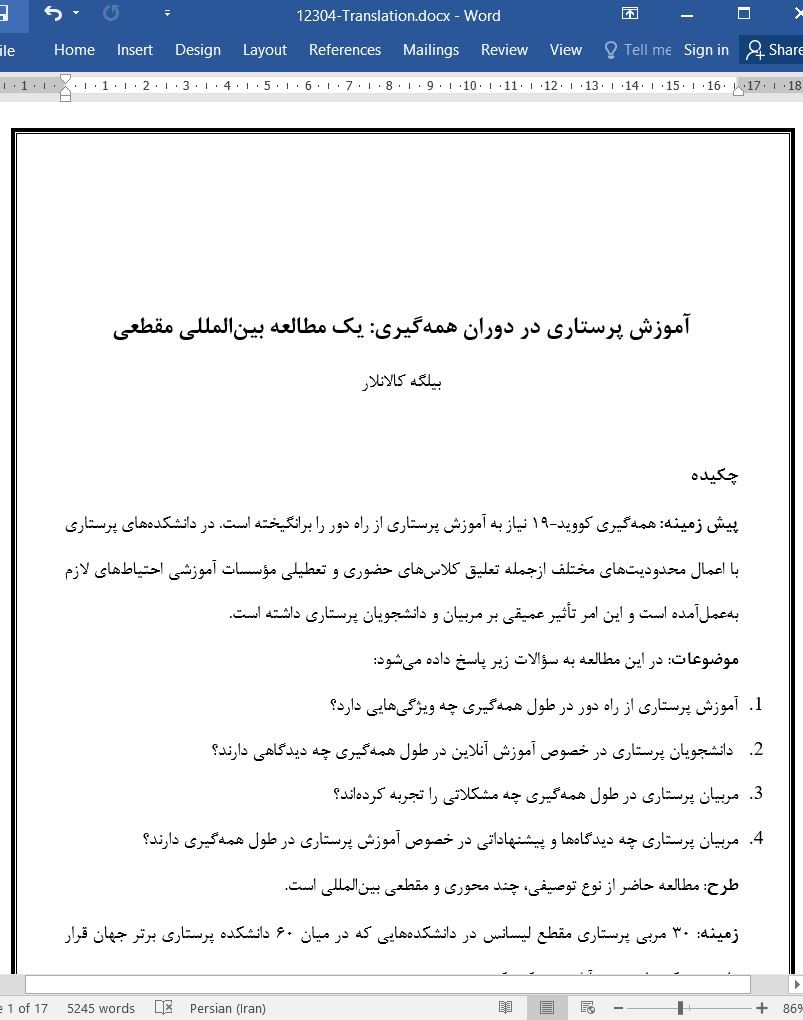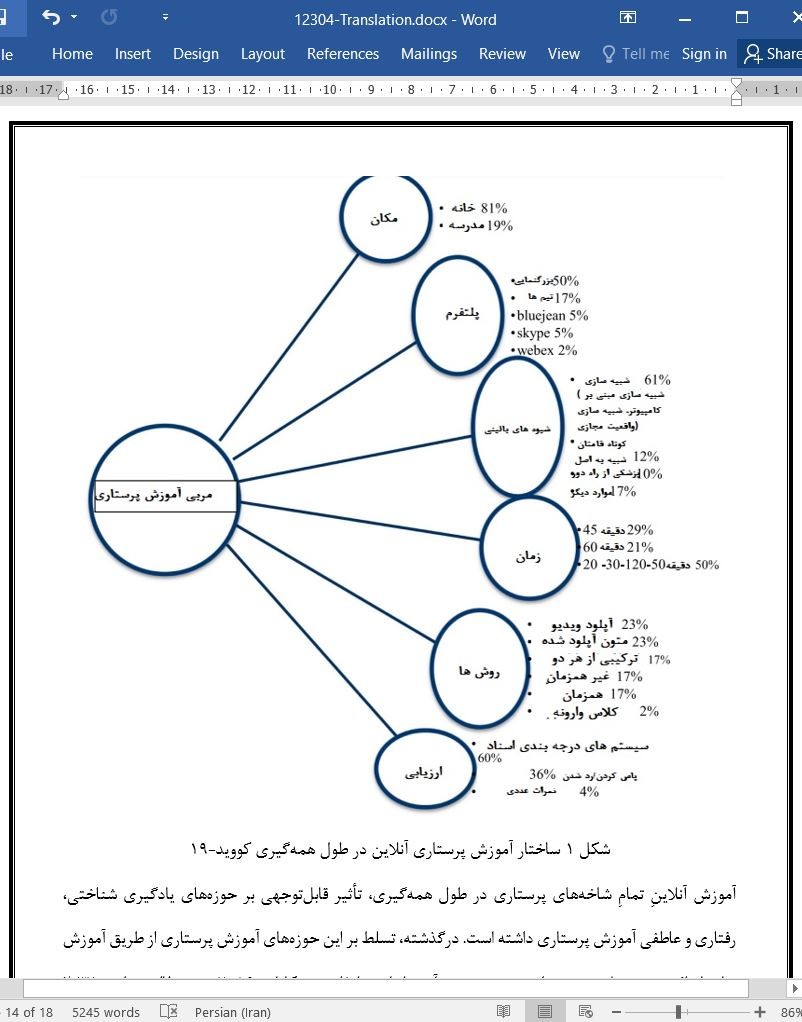
آموزش پرستاری در دوران همه گیری
چکیده
پیش زمینه: همهگیری کووید-19 نیاز به آموزش پرستاری از راه دور را برانگیخته است. در دانشکدههای پرستاری با اعمال محدودیتهای مختلف ازجمله تعلیق کلاسهای حضوری و تعطیلی مؤسسات آموزشی احتیاطهای لازم بهعملآمده است و این امر تأثیر عمیقی بر مربیان و دانشجویان پرستاری داشته است.
موضوعات: در این مطالعه به سؤالات زیر پاسخ داده میشود:
1. آموزش پرستاری از راه دور در طول همهگیری چه ویژگیهایی دارد؟
2. دانشجویان پرستاری در خصوص آموزش آنلاین در طول همهگیری چه دیدگاهی دارند؟
3. مربیان پرستاری در طول همهگیری چه مشکلاتی را تجربه کردهاند؟
4. مربیان پرستاری چه دیدگاهها و پیشنهاداتی در خصوص آموزش پرستاری در طول همهگیری دارند؟
طرح: مطالعه حاضر از نوع توصیفی، چند محوری و مقطعی بینالمللی است.
زمینه: 30 مربی پرستاری مقطع لیسانس در دانشکدههایی که در میان 60 دانشکده پرستاری برتر جهان قرار دارند در یک نظرسنجی آنلاین شرکت کردند.
شركت كنندگان: مربیان پرستاری در برنامه های کارشناسی پرستاری.
روش ها: یک نظرسنجی مبتنی بر اینترنت که شامل سؤالات پاسخ باز و چندگزینهای بود در 60 دانشکده پرستاری که در لیست رتبهبندی دانشگاهی جهانی کیو اس (QS) 2020 قرار داشتند پخش شد.
نتایج: دادهها از 30 دانشکده پرستاری در 30 کشور جمعآوری شد. از زمان اعلام همهگیری، ساختار آموزش از راه دور در پرستاری از کشوری به کشور دیگر شکلهای متفاوتی به خود گرفته است و مربیان و دانشجویان پرستاری هم به شکل یکسانی در طول این فرآیند با مشکلات گوناگونی مواجه شدهاند. یافتههای مطالعه حاضر نشان داد که 65 درصد از مربیان پرستاری آمادگی برای شیوع کووید-19 نداشتهاند، 44 درصد معتقد بودند که نتایج دوره پرستاری از طریق آموزش از راه دور بهدستآمده است و 48 درصد با چالشها و مسائل اینترنت مواجه شدهاند.
نتیجه گیری: ازنظر نویسنده، مطالعه حاضر اولاً به مربیان پرستاری کمک میکند تا در مورد تغییر آموزش به آموزش از راه دور تصمیمگیری کنند، پیشنهادانی را به کسانی که قبلاً چنین تغییری را انجام دادهاند ارائه میدهد یا الهامبخش کسانی است که به دنبال بهبود اثربخشی آموزش مجازی در مواقع ضروری هستند. دوم، دستورالعملهایی را برای مؤسسات آموزشی ارائه میدهد و درنهایت، به اتخاذ اقدامات احتیاطی برای مقابله با مشکلات احتمالی کمک میکند.
6. اختیارات و محدودیت ها
مطالعه حاضر چندین محدودیت دارد. داده های تحقیق محدود به مربیان و سخنرانانی بود که در دپارتمان پرستاری 30 دانشگاه کار می کردند و نتایج نمی تواند به تمام مربیان پرستاری در کل دنیا تعمیم یابد. با توجه به دانش کافی ما، این مطالعه اولین پژوهش درباره بررسی آموزش پرستاری در سطح بین المللی در طول همه گیری می باشد. اختیار اصلی این مطالعه متکی بر طرح چند مرکزی و بین المللی می باشد.
Abstract
Background The COVID-19 pandemic has raised the need for distance learning in nursing education. The necessary precautions have been taken in nursing schools involving the application of various restrictions, including the suspension of face-to-face classes and the closure of educational institutions, and this has had a profound effect on nursing educators and nursing students alike.
Objectives The study seeks to answer the following questions:
1) What are the characteristics of distance nursing education during the pandemic?
2) What are the nursing students' views on online education during the pandemic?
3) What difficulties have been experienced by nursing educators during the pandemic?
4) What are the views and suggestions of nursing educators in regards to nursing education during the pandemic?
Design descriptive, cross-sectional, multicentered and international study.
Settings An online survey was completed by 30 nursing educators working in establishments listed among the top 60 highest-ranked nursing schools in the world.
Participants nursing educators in undergraduate nursing programs.
Method An internet-based survey comprising open-ended and multiple choices questions was disseminated to 60 nursing schools on the 2020 QS World University Ranking list.
Results Survey responses were received from 30 nursing schools in 30 countries. Since the announcement of the pandemic, the structure of distance education in nursing has taken different forms from one country to another, and nursing educators and students alike have encountered a diversity of problems during this process. The findings of the present study reveal that 65% of the nursing educators thought that they had been caught unprepared for the COVID-19 outbreak, 44% thought that the nursing program outcomes had been achieved through distance education, and 48% encountered Internet-related problems.
Conclusion We believe that the present study will (i) aid in the decisions of nursing educators considering a transition to distance education, provide suggestions to those that have already made such a transition or inspire those seeking to improve the effectiveness of practice in obligatory cases, (ii) serve as a guide for educational institutions, and (iii) contribute to the taking of precautions to counter potential problems.
6. Strength and limitations
The current study has several limitations. The research data were limited to nursing educators/lecturers working in the nursing departments of 30 universities, and so the results cannot be generalized to all nursing educators around the world. To the best of our knowledge, our study is the first to investigate nursing education at an international level during the pandemic. The main strength of the study lies in its multicentered and international design.
چکیده
1 مقدمه
2. روش تحقیق
2.1. طرح تحقیق
2.2. جامعه آماری تحقیق و اندازه نمونه
2.3. ابزارهای جمعآوری داده
2.4. جمعآوری داده
2.5. تحلیل دادهها
2.6. ملاحظات اخلاقی
3. نتایج
4. بحث
5 نتیجهگیری و توصیهها
6. اختیارات و محدودیت ها
مراجع
Abstract
1. Introduction
2. Methods
2.1. Study design
2.2. Study population and sample
2.3. Data collection tools
2.4. Data collection
2.5. Data analysis
2.6. Ethical consideration
3. Results
4. Discussion
5. Conclusion and recommendations
6. Strength and limitations
Funding
CRediT authorship contribution statement
Declaration of competing interest
Acknowledgements
References
- اصل مقاله انگلیسی با فرمت ورد (word) با قابلیت ویرایش
- ترجمه فارسی مقاله با فرمت ورد (word) با قابلیت ویرایش، بدون آرم سایت ای ترجمه
- ترجمه فارسی مقاله با فرمت pdf، بدون آرم سایت ای ترجمه



